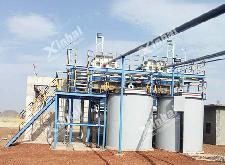

Warm Tip: If you want to know more details about equipment, solutions, etc, please click the button below for free consultation, or leave your requirements!

Ball mill is the common grinding equipment of the mineral processing plant, with appearance rate as high as the heroine in the TV series. It is the quality assurance of mineral processing, which is related to the efficiency of mineral processing and the quality of products. Without steel balls, a ball mill is incomplete and soulless. However, do you know how to add steel balls to the ball mill?
What? Adding the steel ball is also an art?
Yes, the steel ball is not only an art, but also a big art!
The steel ball of the ball mill is consumable item and need to be replaced frequently. We can analyze it from three aspects on the problem of adding steel balls to the ball mill, namely, the filling rate of steel balls, the size of steel balls and the material of steel balls.
1. Filling Rate of Steel Balls for Ball Mill
Steel balls bear the main task of the ball mill grinding operation. The number of steel balls in the mill is closely related to the strength of the grinding operation. From the perspective of physical phenomena, the more grinding balls a ball mill has, the more strike frequency there is, the larger the grinding area, and the stronger the grinding effect. Conversely, if grinding balls aren’t loaded enough, the grinding effect will naturally diminish. In terms of mechanical phenomena, the more balls are loaded, the more power is consumed, and the greater the productivity of the mill will be. In addition, the material in the mill also includes ore and water, resulting in a difference between actual power and theoretical power.
At a higher rotation rate, steel balls in the ball mill are in a complex throw-down state. At a certain filling rate, steel balls will change from a sloping state to a throwing state as the turning speed increases. However, at different filling rates, the rotation rate required for steel balls to change from sloping to throwing is also different. The higher the filling rate is, the higher the rotation speed required to turn to the throwing state.
In summary, we can know that the filling rate has its corresponding adaptation value at different rotation speeds, under which higher filling rate is not always a better one. How to find a suitable filling rate also needs to be judged by experiment.
2. Size of Steel Balls for Ball Mill
The ore is grinded in a ball mill, mainly by the impact force generated when steel balls are thrown off and the relative sliding of steel balls to the ore. The impact crushing force, the grinding ability and grinding capacity are all related to the size of the steel ball. According to the previous test results, the size of steel balls is proportional to the impact crushing force, the grinding ability and grinding capacity under the same amount of steel balls. And it is inversely proportional to the single energy consumption of the steel ball and grinding fineness within a certain range. If the steel ball is too large, it may fail to achieve the required particle size.
Therefore, in the case where the ore to be grinded has a large hardness, a large particle size, and a large grinding grain size, if the size of steel balls is appropriately increased, the effect is remarkable in production increase, energy saving and consumption reduction.
3. Material of Steel balls for Ball Mill
We all know that steel balls in the ball mill are extremely susceptible to wear during grinding process. And steel balls vary in the material, quality and hardness. At present, the mainstream materials on the market are low-chromium cast balls (containing 0.5-2.5% chromium, 1.8%-3.2% carbon), medium-chromium cast balls (containing 3%-7% chromium, 1.8%-3.2% carbon), and high-chromium cast balls (containing more than 10% chromium, containing 1.8%-3.2% carbon), forged balls, hot rolled steel balls, etc.
Generally speaking, the hardness, impact force and breaking rate of the cast steel balls are related to the metallographic structure of steel balls, namely, the composition with same chemical properties, crystal structure and physical properties in metal structure. Generally, the wear resistance of cast steel balls is related to chrome content. The higher the chrome content steel balls have, the better the wear resistance is. Forged steel balls have higher impact toughness, low crushing rate and are not easily deformed. Hot-rolled steel balls is a new type of process with precise dimensions, rounded geometry, high hardness and good mechanical properties. And it is resistant to wear and will not easily deform or crack. Casting steel balls are usually suitable for dry grinding while forged steel balls are suitable for wet grinding. Forged balls is the ball mill grinding medium that commonly used in the world, but hot rolled steel balls are gradually replacing casting steel balls becoming the high-quality grinding balls.
The choice of materials mainly depends on the material to be processed and the economic situation of the enterprise.
Several aspects should be considered when choosing steel balls that have already mentioned above, but specific analysis is necessary to the specific situation. How to add steel balls to the ball mill is an issue that needs to be considered in many ways. The recommended method is to consult an experienced manufacturer or to determine based on the conclusions of the laboratory.
Last: 3 Principles of Choosing the Crushing and Grinding Process
16 Reasons Why Output of Ball Mill Decreases
 3
3
 3611
3611
2How to Replace the Ball Mill Liner?
 4
4
 3328
3328
33 Common Problems and Solutions in Ball Mill Operation
 0
0
 3508
3508


What Are the Differences Between CIP and CIL?
 10550
10550
 0
0